Customer Logins
Obtain the data you need to make the most informed decisions by accessing our extensive portfolio of information, analytics, and expertise. Sign in to the product or service center of your choice.
Customer Logins
ECONOMICS COMMENTARY
Feb 22, 2024
Eurozone downturn moderates as service sector steadies, but price rises cloud rate cut outlook
Business activity in the euro area fell at the slowest rate for eight months in February, according to provisional PMI® survey data, as a stabilisation of output in the service sector offset a further steep downturn in manufacturing. Business confidence about the year ahead improved, hitting a ten-month high and encouraging firms to raise staffing levels at a pace not seen since last July, adding to signs that the eurozone's downturn is moderating.
By country, a deepening contraction in Germany and sustained output fall in France were countered by faster growth in the rest of the region.
Supplier delivery times improved after the delays seen amid Red Sea shipping disruptions in January, taking further pressure off manufacturing prices. But service sector inflation remained elevated by historical standards, causing overall rates of input cost inflation and selling price inflation to accelerate in February to their highest since last May.
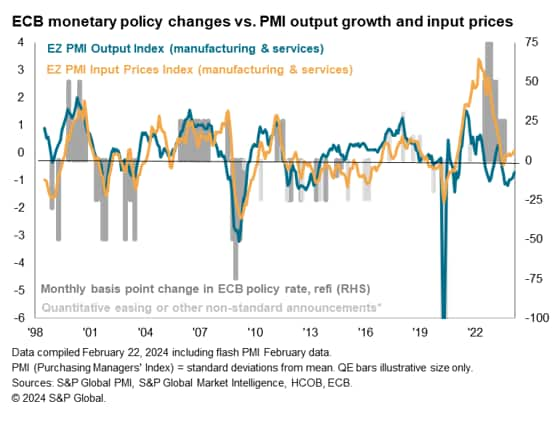
Eurozone downturn cools
The seasonally adjusted HCOB Flash Eurozone Composite PMI Output Index, based on approximately 85% of usual survey responses and compiled by S&P Global, rose from 47.9 in January to 48.9 in February. Although signalling a ninth consecutive month of falling output, February's decline was the smallest since last June.
While the latest reading suggests that the eurozone's deepest contraction since 2013 (if early pandemic months are excluded) has persisted into 2024, the rate of decline is showing signs of moderating in the first quarter. The PMI data available so far for the first quarter point to eurozone GDP contracting at a quarterly rate of 0.15% after a 0.25% decline in the fourth quarter.
The latest provisional GDP data estimated the eurozone economy to have stagnated in the fourth quarter, a reading which the PMI suggests will ultimately get revised lower.
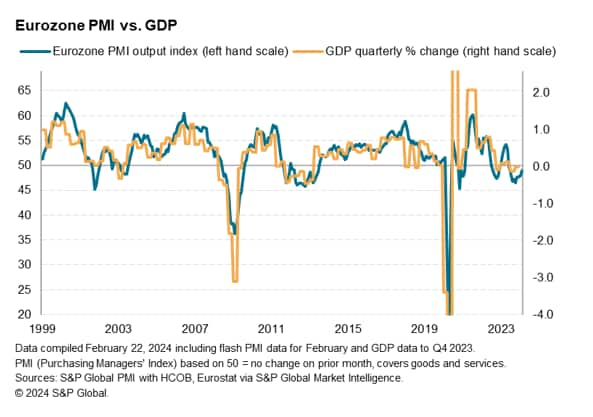
Business conditions continued to vary markedly by sector and country across the eurozone, however, underscoring the weakness of manufacturing in particular, which has in turn hit Germany especially hard.
Manufacturing malaise, services steady
Manufacturing output fell across the eurozone for an eleventh consecutive month in February, the rate of decline accelerating again after the moderation seen in January to register another month of steep contraction. New orders for goods likewise fell sharply by historical standards (albeit the rate of loss cooling slightly for a fourth month running). In contrast, service sector business activity stabilised in February after six months of continual deterioration, linked to an easing in the rate of decline of new business for a fourth straight month to signal only a marginal drop in demand.
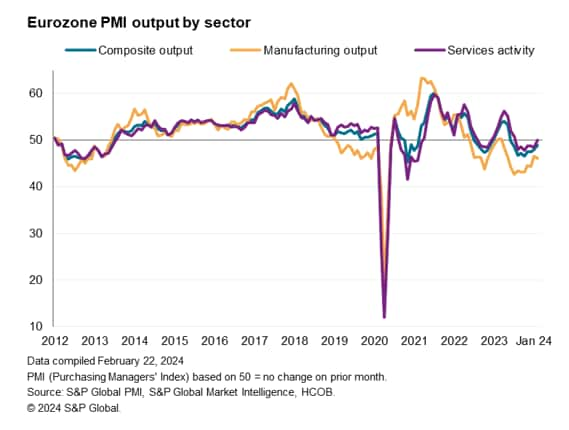
German drag
By country, output fell especially sharply in Germany, dropping for an eighth successive month and at the fastest rate since last October. A moderating downturn in Germany's service sector only partially offset a deepening contraction in manufacturing.

Output also contracted in France, but the decline was the smallest recorded since France's downturn commenced back in June of last year thanks to moderating rates of deterioration for both manufacturing and services sector output.
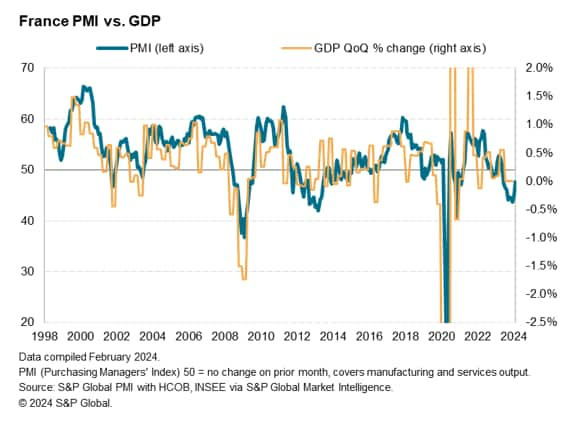
The rest of the eurozone meanwhile collectively reported growth of output for a second month running, contrasting with the declines seen over the prior five months, enjoying the largest monthly improvement since last May. Faster service sector growth was accompanied by a near stabilisation of manufacturing output.
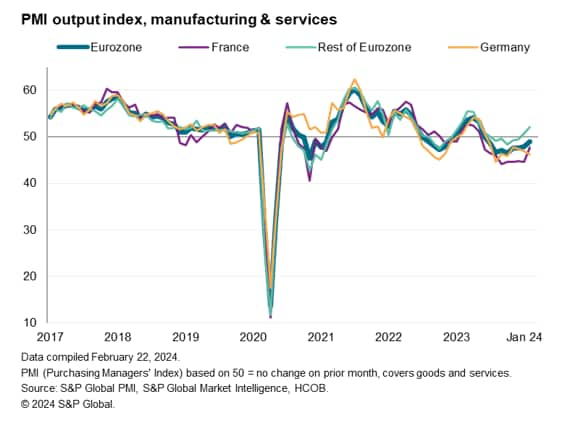
Employment
Employment increased for a second month running in February after two months of decline at the end of 2023. While the overall rise in payroll numbers was only modest, the latest increase was nevertheless the largest since last July.

Again, sector divergences were noteworthy. A steepening rate of job losses in the manufacturing sector contrasted with net hiring reaching an eight-month high in the service sector. A marginal drop in employment in Germany was accompanied by a marginal rise in France and a nine-month high rate of job creation in the rest of the region.

Inventories, supply chains and purchasing
The gloom in the manufacturing sector was further underscored by a continued sharp reduction in input buying by factories, which has now fallen for 20 straight months, in turn resulting in a thirteenth successive monthly fall in inventories of purchases.

Encouragingly, the ongoing reduction in input buying took pressure off supply chains. Supplier delivery times had lengthened for the first time in 12 months in January, largely due to Red Sea related shipping disruptions, but faster lead-times were reported in February in a welcome sign of fewer shipping delays.

Price pressures lift higher
Growth of average input costs across producers of goods and providers of services accelerated for a second successive month to reach the highest since last May. Although well below highs seen during the pandemic, the latest rise pushed the rate of increase further above the survey's pre-pandemic long-run average to signal elevated cost pressures by historical standards. Service sector input cost inflation rose to a nine-month high and prices fell in manufacturing at the slowest rate for 11 months.

Selling price inflation likewise accelerated, up for a fourth month running in February to also hit the highest since last May. Excluding the price surge seen over the two years to last May, February's rate of inflation was the highest recorded since January 2018 and well above the survey's pre-pandemic long-run average.
Although prices charged by manufacturers fell at a slightly increased rate, continuing the disinflationary trend seen for goods over the past ten months, prices levied for services rose at the sharpest rate for nine months, the rate of inflation having now accelerated for four straight months. Excluding the 19-month period to last May, the latest rise in service sector prices was the largest recorded since September 2000.

A comparison of the PMI selling prices data with consumer price inflation suggest that the latest survey data are consistent with some stickiness of CPI around the 3% mark in the near-term, hinting at some difficulty in the ECB's plight to attain its 2% target at least in the first half of 2024.

Outlook
Looking ahead, business optimism about the coming 12 months improved for a fifth successive month in February, rising to the highest since last April. Confidence improved to an 11-month high in the service sector, reviving further from a low-point seen last September. But sentiment in manufacturing slipped slightly from January's nine-month high, albeit remaining far above the low seen last October.

Recent months have seen growth prospects improve amid hopes of reduced cost of living pressures and the expectation of lower interest rates in the year ahead, as well as some signs of reduced inventory reduction policies in manufacturing. Year-ahead optimism nevertheless continued to run slightly below the pre-pandemic average, linked in part to economic uncertainty and global geopolitical concerns.
Access the press release here.
Chris Williamson, Chief Business Economist, S&P Global Market Intelligence
Tel: +44 207 260 2329
Purchasing Managers' Index™ (PMI®) data are compiled by S&P Global for more than 40 economies worldwide. The monthly data are derived from surveys of senior executives at private sector companies, and are available only via subscription. The PMI dataset features a headline number, which indicates the overall health of an economy, and sub-indices, which provide insights into other key economic drivers such as GDP, inflation, exports, capacity utilization, employment and inventories. The PMI data are used by financial and corporate professionals to better understand where economies and markets are headed, and to uncover opportunities.
This article was published by S&P Global Market Intelligence and not by S&P Global Ratings, which is a separately managed division of S&P Global.
{"items" : [
{"name":"share","enabled":true,"desc":"<strong>Share</strong>","mobdesc":"Share","options":[ {"name":"facebook","url":"https://www.facebook.com/sharer.php?u=http%3a%2f%2fwww.spglobal.com%2fmarketintelligence%2fen%2fmi%2fresearch-analysis%2feurozone-downturn-moderates-as-service-sector-steadies-feb24.html","enabled":true},{"name":"twitter","url":"https://twitter.com/intent/tweet?url=http%3a%2f%2fwww.spglobal.com%2fmarketintelligence%2fen%2fmi%2fresearch-analysis%2feurozone-downturn-moderates-as-service-sector-steadies-feb24.html&text=Eurozone+downturn+moderates+as+service+sector+steadies%2c+but+price+rises+cloud+rate+cut+outlook+%7c+S%26P+Global+","enabled":true},{"name":"linkedin","url":"https://www.linkedin.com/sharing/share-offsite/?url=http%3a%2f%2fwww.spglobal.com%2fmarketintelligence%2fen%2fmi%2fresearch-analysis%2feurozone-downturn-moderates-as-service-sector-steadies-feb24.html","enabled":true},{"name":"email","url":"?subject=Eurozone downturn moderates as service sector steadies, but price rises cloud rate cut outlook | S&P Global &body=http%3a%2f%2fwww.spglobal.com%2fmarketintelligence%2fen%2fmi%2fresearch-analysis%2feurozone-downturn-moderates-as-service-sector-steadies-feb24.html","enabled":true},{"name":"whatsapp","url":"https://api.whatsapp.com/send?text=Eurozone+downturn+moderates+as+service+sector+steadies%2c+but+price+rises+cloud+rate+cut+outlook+%7c+S%26P+Global+ http%3a%2f%2fwww.spglobal.com%2fmarketintelligence%2fen%2fmi%2fresearch-analysis%2feurozone-downturn-moderates-as-service-sector-steadies-feb24.html","enabled":true}]}, {"name":"rtt","enabled":true,"mobdesc":"Top"}
]}




